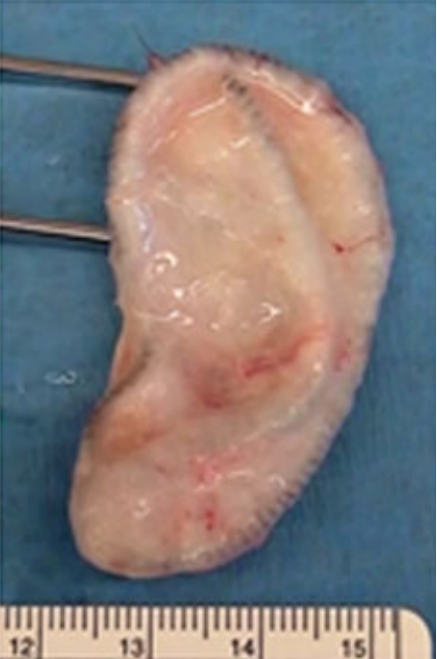Artificial Ear Grown On Rat With Living Tissue From Cows, Sheep; What's Next For Tissue Engineering?

Scientists have successfully engineered a human-like artificial ear from animal tissue. BBC Science reports that the project represents a groundbreaking development in tissue engineering, and a significant step toward growing a new ear from a patient's own cells.
The innovation comes from a team of scientists currently working to develop new, therapeutic options for individuals born with malformed ears or who have otherwise lost them as a result of accidents or medical complications.
The project consisted of several steps and involved a mélange of biological mediums — including living tissue from cows, sheep, and rats. The artificial ear tissue was grown on a three-dimensional titanium "scaffold" — a wire frame designed to replicate the proportions of a human ear, which had been imaged with CT scanning.
The new tissue structure was then implanted into a rat with a suppressed immune system, recalling the controversial Vacanti mouse project from 1997.
"We've demonstrated the first full-sized adult human ear on the rat model," lead author Thomas Cervantes, a researcher at Massachusetts General Hospital in Boston, told BBC News. He added that their findings were significant for several reasons.
"One - we were able to keep the shape of the ear, after 12 weeks of growth in the rat. And then secondly we were also able to keep the natural flexibility of the cartilage," he continued.
Artificial Ear In Clinical Trials
The artificial ear project is thus a proof-of-concept for growing similar structures for clinical trials, as it demonstrates that it's possible to grow in animals the necessary amount of constituent cells. The researchers estimate that the method could reach this trial stage within five years.
"In a clinical model, what we would do is harvest a small sample of cartilage, that the patient has, and then expand that so we could go ahead and do the same process," Cervantes said. "This research is a significant step forward in preparing the tissue-engineered ear for human clinical trials."
The artificial ear is one of several breakthroughs in tissue engineering so far this year. Another example is the artificial trachea transplant that made headlines earlier this summer. Hannah Warren — a two-year-old suffering from tracheal agenesis, which is a rare, usually fatal condition that kept her from eating, drinking, or even swallowing on her own — underwent the transplant. Although the surgery itself was a success, Hannah sadly died a few months later from additional complications.



























